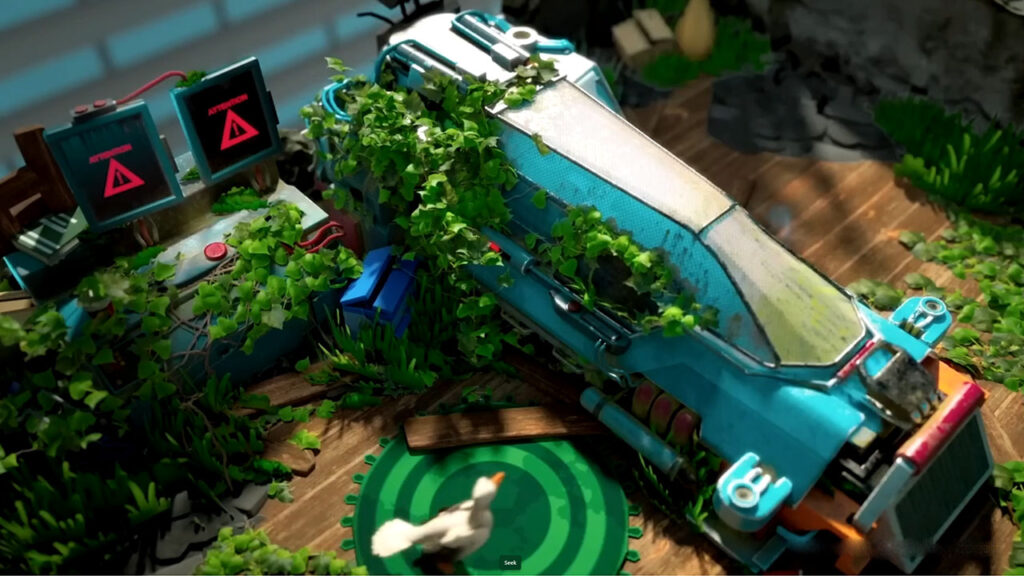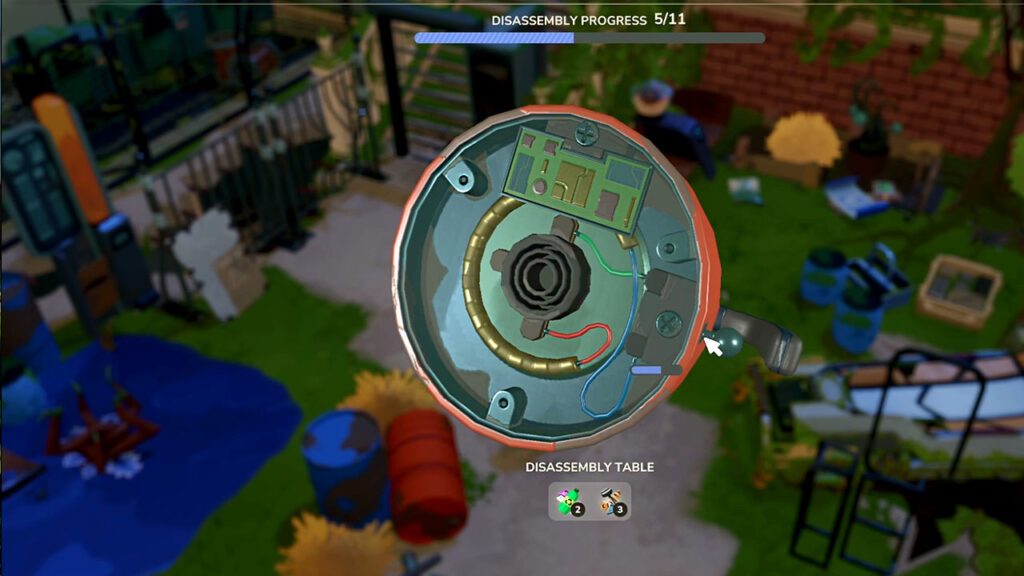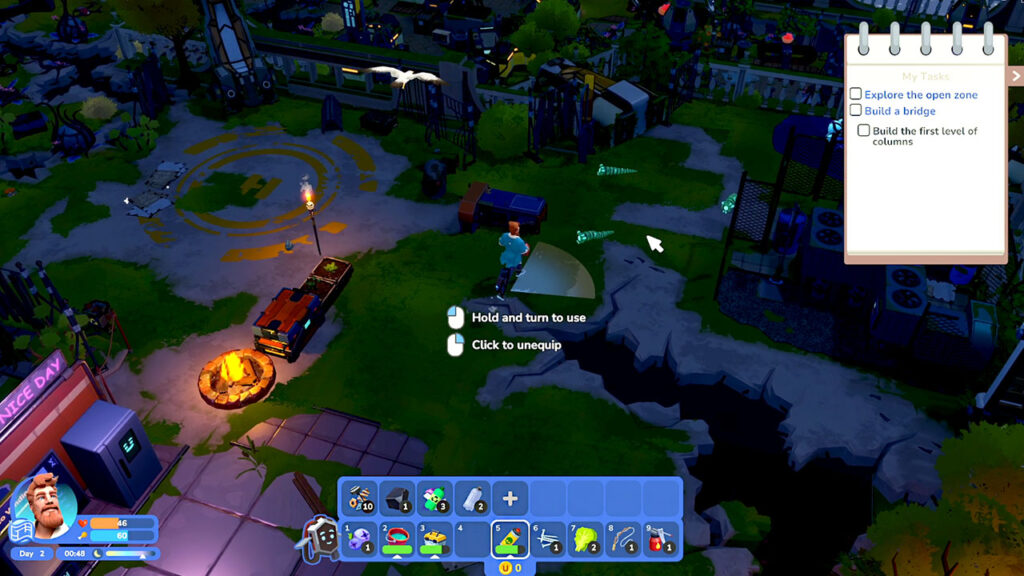Have you ever wondered what it would be like to be the only person left in the world? Without any ferocious zombies or dinosaurs trying to eat ya? What if you could just chillax and make your survival shelter your own personal space, while living your best life?
Let me introduce you to I Am Future, a cozy survival game set in a vibrant post-apocalyptic world.
You start off awakening from a Hibernation pod after being asleep for 6 years, 6 months, and 5 days. You emerge from the pod looking like a tech billionaire who just went for a slight nap, even with cucumber slices falling from your eyes. During the time you have been asleep, the world has been ravished by great tsunamis that have flooded the world, and only the tallest of skyscrapers have emerged. You play as an unnamed male protagonist, whom I will call Handy, as he has a robotic socket where his right hand should be, which comes in very handy as it’s where you will attach a variety of attachments to it to allow you to disassemble and gather a wide variety of items around the world.

The first thing that catches my attention is the art style of the game, is unique in this type of Genre, a little cartoony, with bright vibrant colors, that’s bringing forth a set of calm. I like the way that Mr. Handy has a little bit of pep in his step, and he bounds along, without a care in the world.
Your starting area is fairly confined on the rooftop, overrun with plants and the odd hover car, and kind of looks like a high-tech Hilbilly’s backyard.
When you start, your actions will be very limited, as you will only be able to pick up and disassemble basic items such as plastic containers for plastic scraps and bushes for biomass. One of the first characters you will run into is a talking refrigerator named Earl, who will set you on a set of basic missions that make up the tutorial, as well as give you some cooking tips. You can tell that the developers wanted to keep the game lighthearted, as the dialogue in the game is pretty witty, and you quickly learn that robots play a major role in the world that was.
The UI of the game is straightforward and clean, showing you your health bar and food level. If your food level gets too low, you will start taking a health hit, and if your health falls to zero, You will pass out, and after a few seconds, Mr. Handy will be back up, ready to go with some health and food to boot.

Movement around the game world is pretty standard using the WSAD keys and mouse buttons to pick up items, but some of the hit boxes can be a little off, especially when you have several items in an area, so I do hope this is something the developers can work on. One example is using the lift to get you to the water area for fishing and gathering water; if you’re not standing in the right area or have something equipped, it won’t let you use the lift. It’s not a game-breaking issue, but just a Quality-of-life thing.
The crafting system in the game comes in two varieties: the first is that you can craft basic items from your backpack using items on hand, as well as placing down crafting stations that will give you more crafting options like the campfire for cooking, the workbench for items, and even a resource printer for more complex items to make. When you place down a crafting station or other piece of equipment to be built, an outline of the item will be shown, and when you bring the necessary items to the location, you add them until the item is completed. All in all, I feel the crafting system is very well done and easy to understand. One thing I especially like about the crafting stations is that they each have their own inventory, and you can add commonly used crafting materials, so you don’t always have to have them in your inventory to craft with, like in some other survival games.
Another game mechanic that I love in the game and hope to see a lot more variety of is the disassembly system. Occasionally you will find complete mechanical items, such as the electric tea kettle, and you must manually take them apart to get the resource materials contained within. So, this puzzling little mini-game consists of you rotating the item around and looking for screws that you can take out and covers to remove to get to the goodies inside, like the copper wiring, batteries, transformers, and more. It’s not highly complex, but it is fun and relaxing to feel like MacGyver, taking things apart.

Eventually, the starting area of your rooftop is going to get fairly scarce in terms of resources that you can use, so you will need to explore the surrounding area. Almost every item on the map can be used as a material for crafting, so exploring the surrounding area is paramount to your success. As you rove the rooftops, you will come across new blueprints that will unlock new crafting stations, materials, and even new outfits for Mr. Handy. In the over 8 hours that I have currently been playing, I’ve made it to four different areas on my rooftop to explore, and then there is a bridge you can build to another rooftop that I have not yet completed, so there is a lot of area to explore in this game. Every time you find a new attachment or learn to tear down something new, it opens a plethora of new items to gather and technologies to learn and craft, and it always leaves you with a feeling of accomplishment.
Food is always a necessity in every survival game, and this one is no different. Though not as tough to gather as in some other survival games, you are able to eat any biomass you are able to gather from plants. Cooking up the leafy greens and learning to craft better, and more exotic foods is a way to save on resources and boost your health and food in one fell swoop. Earl will give you some tips on starting recipes, but many are learned by trial and error in the Chef mode, where you add different ingredients and see if you can make something delicious or at least useful. You won’t lose any ingredients as you test them out, but it can be a bit tedious as you try and swap out each different cooking ingredient to see if you can find some secret recipe.
So, I have explained one of the three methods of getting food. The first is foraging for food around the map, and the next is fishing. As you make your way to the ole fishing hole, you will come across a fishing pole with some bait. Fishing is simple: throw your pole in, wait for something to bite, then play a little minigame where a disc pops up, and a hand goes around the disc. Click the mouse when the hand is in the right spots, and viola, you pull up a secret from the depths. It could be. A crafting material, a clam, or a fish, and that’s about it.
Fish without any bait, and you will get resources or a clam; use the clam as bait, and you will get a specific fish; use a worm, and you get another specific fish; there doesn’t appear to be much randomness to fishing, and I am unsure if that’s a good thing or a bad thing at this moment.

The third way to get food, and one of my favorites, is farming. Farming is simple enough; find some fertilizer and a plank, and you can make a Garden bed. Throw some seeds in the bed, wait a bit, add water, and then harvest when ready. and usually when you harvest your crops, you will get seeds in return to replant the harvested crop. Fresh water to water the crops isn’t too hard either, as you just need to take the lift to the fishing hole, use a bucket to pull up some salt water, and then use the campfire to turn it into fresh water. Easy enough if you have only a few garden beds, but once you start getting more, you’re going to need some sprinklers, and that takes us to another mechanic of the game: Automation.
One of the cutest and most helpful features of the game is the automation. You have simple automation, such as the sprinkler system that you can manually add water to, to water your plants for you, or you can even put together some of your own robotic minions to do chores for you, collect resources, etc., and you can even customize how they look, but they will need a charger station to recharge, so for that you need electricity. Electricity isn’t that hard to create once you learn the blueprints for making a biomass generator. Throw some plant matter in, and electricity comes out. Build some power poles to direct it, hook up more appliances to it, and you’ve got a fully functional base. But since you have almost free power, you might want to mine some crypto.
That’s right. Mine some U-Coin right from the comfort of your very own rooftop paradise. If you keep the electricity flowing, it will continue to make U-coin for you that you will be able to use at hoarders shop to get some much-needed looks, new seeds, equipment, etc. The only downside is that there is currently no selling system that I have found to allow you to trade some of your overflowing mats for something more needed.

The last thing to go over is the right time. The future does have a day and night cycle that opens up a few different issues. Some of the seeds you plant, such as the mushrooms, only grow during the night, while bright blooms only bloom during the day. But there is a more ominous issue that arises when the sun sets, and that’s the Electrosites, strange, mutated creatures that seem oddly attracted to electricity and crops. Currently, I have only run into one type, and that is the leach, a blue slug-type creature that slowly moves toward crops. Open flames and electrical devices: if the leeches reach an item they want to eat for lunch, they will start to munch on it till it is destroyed. And once they have their fill, they will burrow into the ground and create a spiny bush that will spawn more leeches.
Currently, the only way to combat the leeches is to pick them up and move them, which causes health damage in the process; craft a bug spray that works against them and their spiny bushes; or craft different types of barricades to keep them at bay. Not only are the leeches a pest, but they are also a source of resources; you can use their corrosive goo to make batteries and their tails as bait to fish with. And the developers have stated that they plan to add more pests to deal with, like persistent caterpillars and even dangerous Hornets.
I Am Future is one of those games that has a lot to offer a variety of different players. The game kept me wanting to come back for more, and I am surely going to put much more time into it to see what’s the game has in store for us.
My final rating for I Am Future in its current state is an 8.5 out of 10.


Leave a Reply
You need to Sign in to post a comment.